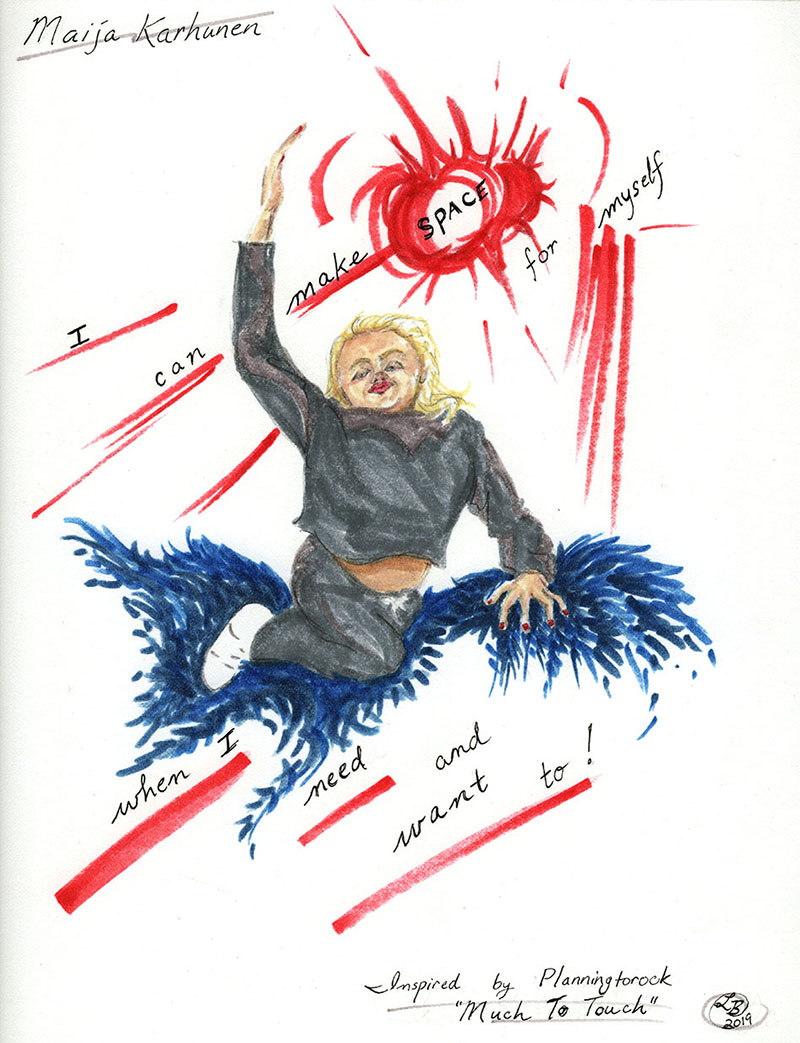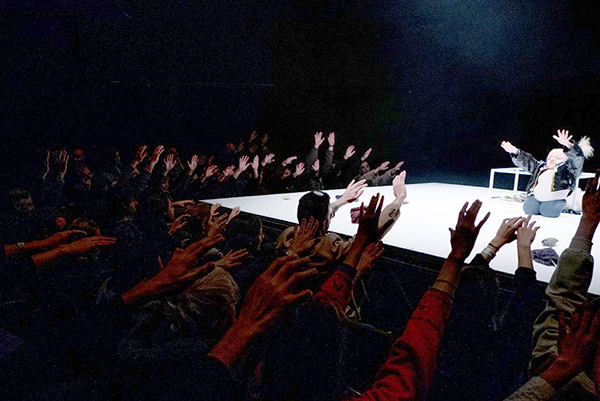Maija Karhunen: “I Can Make Space For Myself”
BY SILVA LAUKKANEN; EDITED BY EMMALY WIEDERHOLT; ILLUSTRATED BY LIZ BRENT-MALDONADO
Maija Karhunen works with choreographers and directors in Finland and Europe. She studied dance and choreography in Finland, the Netherlands, and Germany. Her interests lie in the all-encompassing performativity of the human, questions of power, intimacy, the personal, and the grotesque. She works also in the field of dance writing and critique.
To learn more about the Discussing Disability in Dance Book Project, visit here!

Image description: Maija is depicted wearing gray and sitting astride blue fur suspended mid-frame, her left hand resting on the fur and her right hand reaching up to a red star of energy. Red beams of energy fall toward her along with the quote, “I can make space for myself when I need and want to!”
~~
How did you get into dance and what have been some highlights in your dance history?
I was attracted to dancing because it was my sister’s hobby, and I wanted to do the same. I was in my early teenage years and it was quite difficult to find a place where, as a disabled teenager, I could dance as a hobby. My physiotherapist was working in a school for disabled children and there she found an announcement about a group. When I got older, I did some workshops with Alito Alessi and started to dance with people who were doing integrated dance in Finland at that time. I was thinking about a completely different career, however, and that was to work as a journalist. With a friend’s encouragement, I did one year of training in dance and somatics. I moved more than I had done before, and my body changed a lot. Then I studied for short periods in some dance and choreography schools in England, Holland, and Germany. A big turning point was to go to all these dance schools which hadn’t usually had disabled students before. At that point and earlier also, I was very active; I was just so eager to dance and learn wherever I could, so I just showed up and didn’t question if I could be there or not. For some reason, I had the courage and confidence to do that…it’s a mystery to myself how I did that. A highlight is also when I found myself working in the field professionally. I have already worked with so many interesting people. That’s definitely a constant highlight.
How would you describe your current dance practice?
I work with very different choreographers, so my dance practice varies a lot accordingly. In both pieces that I’m working on at the moment, music is a lot of the focus. One of the works is on electronic music, so it’s a lot of dancing to beats. The other work has classical music in it, but interestingly, the questions are quite similar: What is it to dance to music and be as close to music as possible? In both works, we are also asking: What is togetherness on stage and what does it mean to dance together? As a collective, what does it do to individuality?
When you tell people you are a dancer, what are the most common reactions you receive?
In Finland, dance is a very popular hobby but, as an art form, it’s not very familiar to many people. The question often is, “Do you dance alone or with a partner, and to what kind of music?” People’s association is often social dance, dancing to music, not the art form or something that somebody would do professionally. People associate it also with competitive wheelchair dancing.
In the professional dance field, there is a lot of positive interest. People think it’s great that I’m a dancer, and there are also political reasons for that, which I embrace but which can sometimes feel like a big responsibility and one-dimensional. Still, I try to be a bit more vocal about myself, saying, “Hey, I’m here and I’m also dancing,” because I realize the political importance of that. But when an individual carries that message, it’s often a bit difficult. For example, I get the most positive feedback when I talk about my experience exactly from the point of view of a disabled person, which feels strange to me. It’s a lot about people’s projections on me. I find there can be a lot of expectations that I, as a disabled person, must have very special genius thoughts or my experience must be so very different from other people’s. It can be this othering. A fellow artist just said in a rehearsal situation that they are nervous to dance with me. It’s human, I guess, because many artists never seem to have encountered a disabled person. If they then say they are very aware of the world that surrounds them, or say that they pay attention to diversity or whatever, I find it a bit hypocritical.
What are some ways people discuss dance with regards to disability that you feel carry problematic implications or assumptions?
Exactly this, what I already mentioned, all these different projections, special attention, or othering. People might want to see me empowered because that gives them a good conscience or whatever. Or they want to make space for me. I can make space for myself when I need and want to! Many times, I find myself wondering what people actually are thinking. People are very polite, and I get scared they might think I’m too fragile to receive honest feedback (which I am of course!) and they feel they have to like everything I do. And of course when I get grants and opportunities, I think it’s only because I’m there to fill a diversity quota, like I’m the disabled one they must support. So I struggle a lot to believe in myself because of all this.
Maybe we also in some situations need to put a disabled person on a pedestal and just see a disabled person as strong, amazing, and great. But we’ve seen too much of these kinds of individual stories and it has risks, obviously. I think it would be good that we all became more aware of our projections on others. What we don’t talk about that much is the structural position of disabled people in society. Maybe that brave and courageous person had wealthy, educated, white parents and therefore had a lot of support, and it was actually quite easy to become courageous and brave. Disabled people are not equal in relation to non-disabled people but also not among themselves. Depending on society and what kind of support, resources, and accessibility is available, just doing something like choosing dance as a profession is not necessarily an act of bravery. Also, reporters could be asked to reflect on how often and in what roles a disabled person is represented in their media. Are there disabled people represented as experts of different fields, not just through their disability? Are there disabled reporters working in the media?
Do you believe there are adequate training opportunities for dancers with disabilities? If not, what areas would you specifically like to see improved?
Definitely not. In Finland, for example, professional dance training still has a very conventional attitude; it’s a given that it cannot include people with disabilities. Educational institutions change slowly, although I think many of them would like to be more open and could be practically, but maybe it’s bureaucracy that stops them. There’s a lot of inclusive training opportunities in improvisation, but in what could be called dance techniques, there aren’t so many opportunities. I guess a variety is lacking. But I’ve also learned a lot through just working. You can find input from so many different experiences, it doesn’t just have to be established training and dance education.
Would you like to see disability in dance assimilated into the mainstream?
I guess it’s a question for everyone to figure out themselves, about mainstream and marginal and what one’s goal and personal interest is. I’m not interested in staying in a category separated from possibilities or connections with many kinds of people, but I’m not interested in creating new normativity either. It’s quite hard to imagine answers to this question. I would like to get rid of othering because I yearn for connection. I think disability can bring an awareness that could be beneficial for other people as well. For example, I sometimes need practical help from others in working situations. Maybe the presence of a disabled person can highlight that we are dependent on each other, and it could be more acceptable to ask for help, as an opposition to the individualistic culture that we live in now.
What is your preferred term for the field?
I guess “integration” is always referring to someone outside the norm or mainstream being integrated into it. “Inclusion” carries different meanings; it’s about including someone as they are and who they are, not expecting them to change themselves.
In your perspective, is the field improving with time?
I want to question why we need this category or field in the first place. I personally don’t believe in creating this separate field where people with disabilities can do dance and art but not elsewhere. That’s also not how I live my life. But I do understand that there are people for whom the work is very important, and it provides a chance to do something when so many opportunities and possibilities are generally not available. I think it’s also a lot about identity: How much is disability part of identity? How much does mixed abilities dance want to stay in the margin and be a kind of subculture in the dance field? That’s also okay. But often within the field, there is the desire to stop categorizing. If that’s the desire, then one needs to take the step and not create this category.
It’s difficult to say if the field is improving with time because I don’t follow it so thoroughly, but I think there are some interesting people who work in this field and I’ve also seen interesting works. I think it’s good the field questions itself maybe a bit more, for example exactly which term to use and so on.

Photo by David Wohlschlag
Image description: Maija is pictured far right of the frame on her knees with both hands waving above her head. She is on top of a white stage, surrounded by a crowded audience, everyone raising both hands as well.
~~
To learn more about the Discussing Disability in Dance Book Project, visit here!
